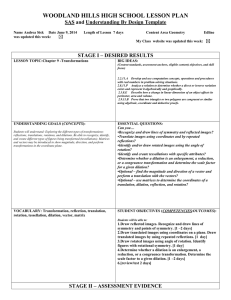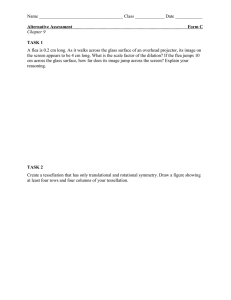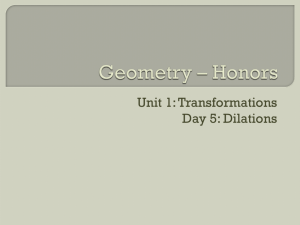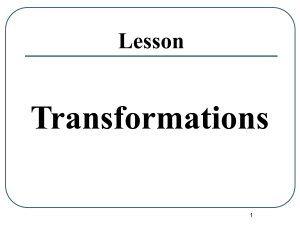WOODLAND HILLS SECONDARY LESSON PLANS
advertisement
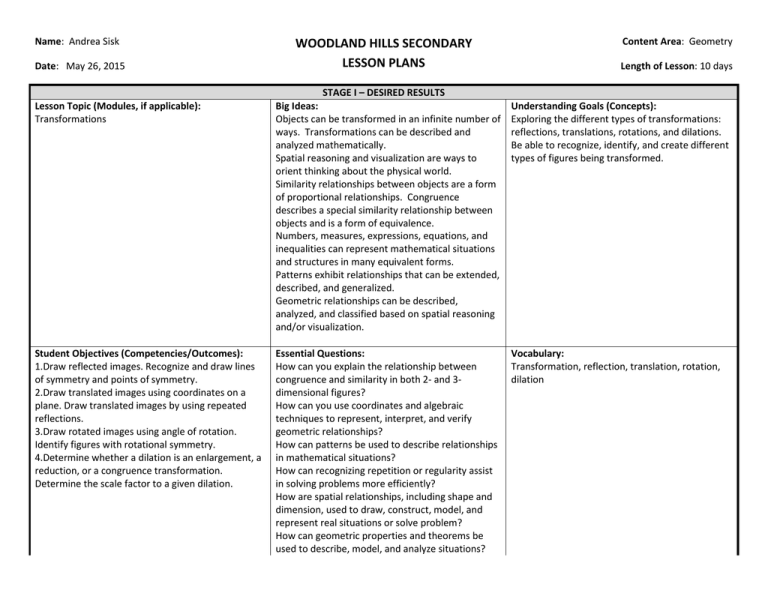
Name: Andrea Sisk Date: May 26, 2015 WOODLAND HILLS SECONDARY LESSON PLANS Content Area: Geometry Length of Lesson: 10 days STAGE I – DESIRED RESULTS Lesson Topic (Modules, if applicable): Transformations Big Ideas: Objects can be transformed in an infinite number of ways. Transformations can be described and analyzed mathematically. Spatial reasoning and visualization are ways to orient thinking about the physical world. Similarity relationships between objects are a form of proportional relationships. Congruence describes a special similarity relationship between objects and is a form of equivalence. Numbers, measures, expressions, equations, and inequalities can represent mathematical situations and structures in many equivalent forms. Patterns exhibit relationships that can be extended, described, and generalized. Geometric relationships can be described, analyzed, and classified based on spatial reasoning and/or visualization. Understanding Goals (Concepts): Exploring the different types of transformations: reflections, translations, rotations, and dilations. Be able to recognize, identify, and create different types of figures being transformed. Student Objectives (Competencies/Outcomes): 1.Draw reflected images. Recognize and draw lines of symmetry and points of symmetry. 2.Draw translated images using coordinates on a plane. Draw translated images by using repeated reflections. 3.Draw rotated images using angle of rotation. Identify figures with rotational symmetry. 4.Determine whether a dilation is an enlargement, a reduction, or a congruence transformation. Determine the scale factor to a given dilation. Essential Questions: How can you explain the relationship between congruence and similarity in both 2- and 3dimensional figures? How can you use coordinates and algebraic techniques to represent, interpret, and verify geometric relationships? How can patterns be used to describe relationships in mathematical situations? How can recognizing repetition or regularity assist in solving problems more efficiently? How are spatial relationships, including shape and dimension, used to draw, construct, model, and represent real situations or solve problem? How can geometric properties and theorems be used to describe, model, and analyze situations? Vocabulary: Transformation, reflection, translation, rotation, dilation STAGE II – ASSESSMENT EVIDENCE Performance Task: Formative Assessments: Students will actively participate in mini-lessons, guided and independent Pre-assessments, open-ended higher-order-thinking questions, think-pairpractice, activities (including authentic problem-solving tasks and vocabulary), share, graphic organizers, do nows, observation of guided and independent and group work. Also, students will demonstrate adequate understanding via practice, brief in-class writing prompts an end-of-chapter test and project. STAGE III – LEARNING PLAN Interventions: Flexible grouping, students will be encouraged to attend Math Lab and College and Career Access Center tutoring. Materials and Resources: Textbook and notes Instructional Procedures*: Monday Date: 5/25 Day: Tuesday Date: 5/26 Day: A Wednesday Date: 5/27 Day: B Thursday Date: 5/28 Day: A Friday Date: 5/29 Day: B Take final exam Review for Final Review for Final Take final exam Assignments Procedures Review for Final Exam *Include Do Now, Mini Lesson, Guided Practice, Independent Practice, Summations/Formative Assessments, Reflections “Do Now”- Write 5 lines: what do reflection, translation, rotation, and dilation mean in real life? “Mini Lesson” – Transformations: translations, rotations, dilations and reflections. “Guided Practice” – Reflect, translate, rotate, and dilate a pre-image. “Independent Practice” – Students will create images from pre-images using reflection, translation, rotation and dilation. “Formative Assessment” – Observe students during “Do Now”, “Guided Practice” and “Independent Practice”. Worksheet 1
